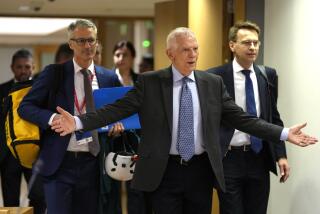European bailout fund may more than double to $1.4 trillion
- Share via
Reporting from London — European leaders are closing in on an agreement to fight the region’s debt crisis by making their bailout fund worth more than $1.4 trillion, partly through public and private investments they hope will come from fast-growing countries such as China and Brazil, German officials said Monday.
Leading members of Germany’s Parliament, who were briefed by Chancellor Angela Merkel, told reporters that the bailout fund was likely to be leveraged to more than twice its present size of $600 billion.
The boost would come through using the emergency backstop to insure holders of Eurozone public debt against a portion of their potential losses and by setting up a fund that could attract outside investors such as the government of China. Both options would multiply the power of the bailout fund without demanding more money to be pitched in by the Eurozone governments themselves, which are leery of inciting taxpayer ire.
Increasing the firepower of the bailout fund — formally known as the European Financial Stability Facility, or EFSF — is considered crucial in the battle against the debt crisis, because its current size is too small to prop up major economies such as Italy and Spain if they come under attack from the markets. Greece, Ireland and Portugal have already received emergency aid, depleting the amount of money available to help other Eurozone countries.
“There will be a leveraging of the EFSF,” Juergen Trittin, a leader of Germany’s Green Party, told reporters in Berlin on Monday. He said the amount was likely to exceed 1 trillion euros, or about $1.4 trillion.
Trittin’s comments, and those of other German lawmakers, came a day after European Union leaders met in Brussels to hammer out the details of a “grand plan” to contain the gravest challenge to face the euro since its launch in 1999.
European officials are expected to unveil their strategy at a summit Wednesday in what could prove to be a make-or-break moment in the debt crisis, which has intensified far more quickly than leaders have been able to mount a credible response.
Whether more than doubling the size of the bailout fund will do the trick is unclear. Many analysts have said that a fund worth nearly $3 trillion would be needed to calm investors.
As part of the rescue plan, officials are also trying to work out a proposal for slashing the debt burden of Greece, the epicenter of the crisis. It now appears that Greek bondholders will either be asked or forced to take losses of up to 60% on their holdings of Greek debt, a move that will be met with heavy resistance from many of Europe’s biggest banks.
Officials have already largely agreed on the third element of their strategy, a roughly $140-billion recapitalization of European banks. The extra money, to be raised from commercial investors if possible, is to provide the banks with a cushion against the losses they would sustain from a write-down of Greek debt.
Merkel briefed German lawmakers on the outlines of the rescue plan Monday in order to start securing their backing. They are to vote on the plan Wednesday before she attends the EU summit, and she wants to arrive in Brussels with a strong mandate.
More to Read
Sign up for Essential California
The most important California stories and recommendations in your inbox every morning.
You may occasionally receive promotional content from the Los Angeles Times.











